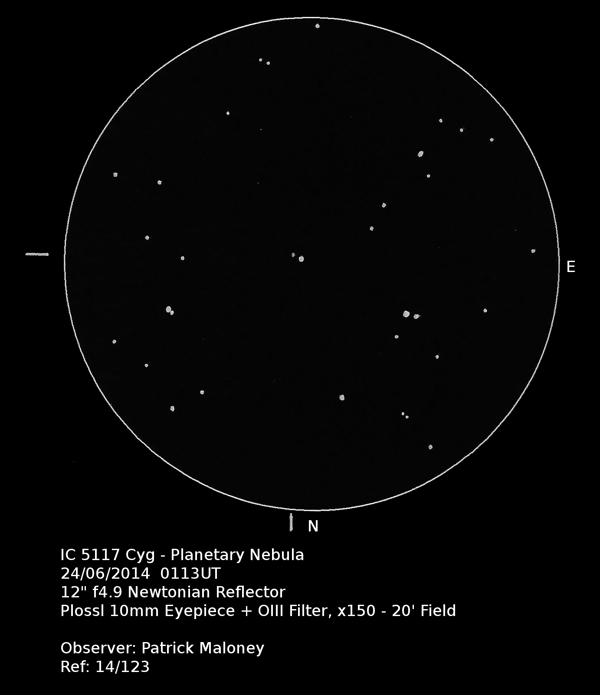NGC 6910 and IC 5117
August 2023 - Nebula and Cluster of the Month
The Milky Way continues to hold sway throughout August. With astronomical darkness lengthening to an hour and three-quarters for mid-Britain by the end of the month and Cassiopeia, Cygnus and Aquila arching above our heads, there is plenty to look at.
Riding high this month is Cygnus, one of the north’s most crowded constellations. We’ll look at two examples this month, an open cluster and a planetary nebula.
NGC 6910 lies 30’ north and slightly east of second-magnitude gamma Cygni, the heart of the swan. It was discovered by William Herschel on 17 October 1786. He described it as A small cluster of compressed scattered stars of various sizes. Extended like a forming one.

I’m not sure what ‘Extended like a forming one’ means. A forming open cluster? Maybe. If so, it would appear a prescient comment, as NGC 6910 is indeed a young cluster, being formed mainly of early-type stars of spectral classes O and B.
The Trumpler classification is given by Archinal & Hynes as I3m n, indicating that it is a well-detached cluster with strong central condensation, it has a wide range of magnitudes amongst its members and contains 50–100 stars. Specifically, they state it has 66 member stars. The detached ‘n’ refers to nebulosity which may be associated. This is the huge swathe of nebulosity that surrounds gamma Cygni.
The Wikipedia entry for this object gives a Trumpler classification of I2p, meaning that it has only a moderate range of brightnesses and is poor in stars (fewer than 50). The entry then goes on to describe 125 stars, probable members of the cluster, are located within the central part of the cluster, and 280 probable members are located within the angular radius of the cluster.
This would make it a rich cluster, not a poor one. I suppose with reference material, you get what you pay for.
Most sources give an angular diameter for the cluster of around 10’, though looking at proper motions of stars in the field, I can see a number of stars that appear to be sharing a common proper motion over a diameter of at least 30’.
Archinal & Hynes give the magnitude of the brightest star as 9.61. There are, however, two very prominent stars in – or at least in the line of sight of – the cluster, lying at the northwest and southeast edges of the central condensation. The northwest star, HD 194241, is of spectral type K2 and is magnitude 7.4. It has proper motion virtually opposite to that of the member stars. It cannot be a member.
The southeast star, on the other hand, has a spectral type of B0 and a proper motion quite comparable with the member stars. At magnitude 7.1, my rough and ready reckoning makes this the brightest member star. There are several other brightish stars across a good half-degree of sky here that at least superficially seem to share a common proper motion. Maybe this cluster is bigger than current estimates suggest.

I made an observation, with a 12” Newtonian reflector at a magnification of x150 and a field size of 20’. I found the cluster to be well detached and moderately compressed. It comprises two 7th magnitude stars, several 10th-magnitude and many fainter. It has a triangular form and the most prominent feature is a knot of 10th-magnitude stars. I found both the 7th-magnitude stars appeared orange, despite one being a B-type. The density of interstellar dust and gas between us and NGC 6910 reduces its brightness by about one magnitude and does lend a yellowish hue to these blue-white stars.
Our second object for August, IC 5117, is a tiny planetary nebula lying one degree south of Rho Cygni. It was discovered photographically by Williamina Fleming in 1905 and made its debut to the world in the Second Index Catalogue in 1908.

It is classed as a ‘compact’ planetary nebula, and is only about 1” in diameter, making it potentially challenging to spot as anything other than a star. The IC description is terse; Planetary, stellar
, but as with the other well-known compact planetary, IC 4997 (see this column for September 2020), there’s more to it than that.
The nebula shines at magnitude 11.5, and spotting a stellar object of that magnitude in a crowded Milky Way field may seem somewhat daunting. However, an OIII filter will make the identification relatively painless. A UHC filter will also work, but not as dramatically. The central star is magnitude 17.2, so that’s not going to trouble you.

I made an observation of it in June 2014 and found it pretty bright and easy, though stellar at all magnifications. It lies about 20” from a magnitude 9.9 star and it is clearly fainter than this star. The OIII filter brightens the object so that it appears brighter than the ‘companion star’. It was identified this way. Even at x450, it remained stellar.
| Object | RA | Dec | Type | Magnitude |
|---|---|---|---|---|
| NGC 6910 | 20h 23m 12s | +40° 46’ 48” | Open cluster | 7.4 |
| IC 5117 | 21h 32m 31s | +44° 35’ 53” | Planetary nebula | 11.5 |